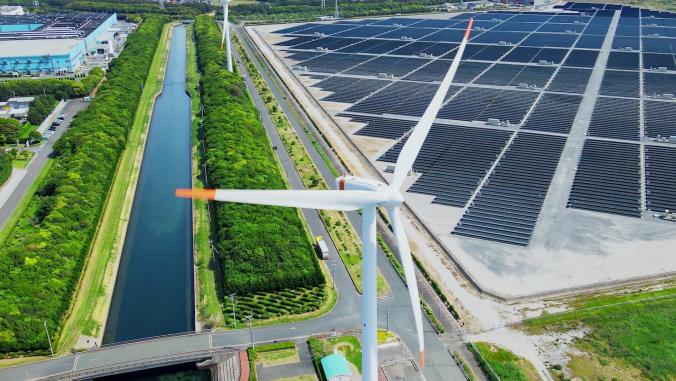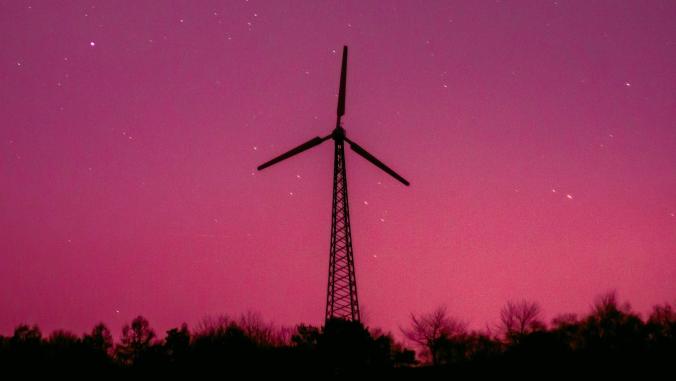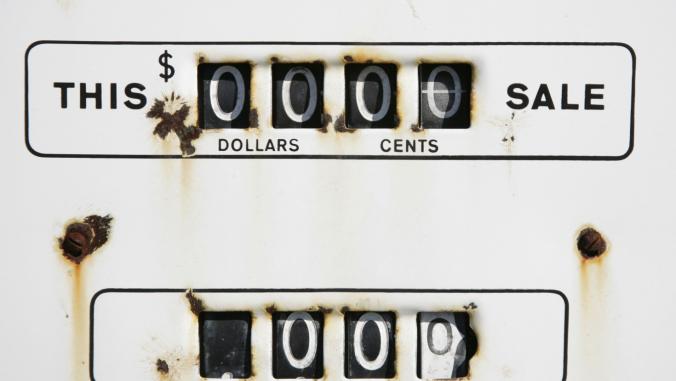How China's 'Belt & Road' initiative could make or break the Paris Agreement
China is eyeing $12 trillion investment across 126 developing countries by 2030, but will the resulting infrastructure be low carbon?

Xi Jinping, President of the People's Republic of China, delivers his speech at the Paris COP21 in 2015, the United Nations' conference on climate change.
More often than not, the spotlight for climate action tends to shine on the world's highest emitting economies. And quite understandably so: China alone accounted for around 27 percent of the total share of global greenhouse gas emissions in 2017, followed by the United States at just under 15 percent and the EU around nine to 10 percent, altogether making up more than half of the world's emissions. They are the world's economic powerhouses, after all, able to leverage the largest levels of investment towards driving innovation and clean technologies at scale.
It can be easy, therefore, to miss the pivotal role many other developing countries will have to play in maintaining a habitable climate across the planet. But as a new report shows, the trajectory of more than 120 developing countries set for major infrastructural investment through China's "Belt and Road" initiative over the coming decades could make or break the world's Paris Agreement goals.
"This group of countries have at current rates the fastest-growing carbon emissions over the next 20 years of any part of the world, and I think that has been ignored because it is not one place," study co-author Simon Zadek tells BusinessGreen. He is a senior visiting fellow at Tsinghua Centre for Finance and Development (Tsinghua CFD), one of the organizations behind the report alongside U.K. analyst firm Vivid Economics and U.S. NGO the ClimateWorks Foundation. "I think this report gives a bird's eye view on this region, which has not been out there in quantitative terms before."
Nicknamed the "New Silk Road," 126 nations have signed up to the Belt and Road (B&R) initiative, first proposed by China in 2013 in a bid to mobilize huge sums of capital towards boosting the infrastructure and economic connectivity of what are, in the main, fairly low-income countries. A huge number of projects have been earmarked in countries spanning Asia, Africa, Europe and North and South America.
And while estimates vary, hundreds of billions of dollars are thought to already have been invested by China to date in projects covering energy, roads, railways, dams and ports, to name just a few. These include investments in freight train services between China and Europe, high-speed rail in Indonesia, two hydropower dams in southern Argentina and a port and airport in Djibouti, for example. But Chinese banks are also big lenders for coal projects all over the world, particularly in South Asia and the Balkans, raising concerns about the climate impact of China's growing economic power around the world.126 nations have signed up to the Belt & Road initiative, first proposed by China in 2013 in a bid to mobilize huge sums of capital towards boosting infrastructure and economic connectivity.
So while these developing countries already today account for almost 60 percent of the world's population and a quarter of global GDP, through the B&R initiative they are expected to see more than $12 trillion of infrastructure investment up to 2030. This inevitably will have a massive impact on geopolitics, and also global emissions.
While these countries accounted for 28 percent of global emissions in 2015, based on business-as-usual levels of growth this will rise to 66 percent by 2050, according to the report. That holds true even if other non-B&R countries follow a Paris Agreement-compliant pathway. Such an outcome would deliver more than double the emissions allowed under the carbon budget for maintaining average global temperatures below 2 degrees Celsius.
The urgent need to rein in the growth of carbon emissions in these B&R countries and ensure that $12 trillion of investment is rigidly harnessed to low carbon infrastructure and the "well-below" 2C target set out in the Paris Agreement scarcely could be clearer. For if action to decarbonize only takes place in the world's top economies of today, unhinged growth in developing B&R countries could be enough to result in nearly 3C of warming and catastrophic climate breakdown, according to the report.
"The nature of infrastructure projects means that carbon emissions are locked in at design and implementation stage," Zadek says. "It is imperative to act immediately to decarbonize expected infrastructure investments in countries involved in the Belt and Road Initiative, in order to avoid overshooting the Paris Agreement targets and potentially placing the world on the pathway of 3-degree warming."
But while the urgency is clear, these trillions of dollars of forecasted infrastructural investments also present a huge opportunity to sustainably boost prosperity in these B&R countries at the same time as ensuring the planet keeps on a 2C pathway.These trillions of dollars of forecasted infrastructural investments also present a huge opportunity to sustainably boost prosperity in these B&R countries.
"The Belt and Road Initiative is an opportunity, because it allows a concentrated plan which would be much more difficult if there were 126 countries all working independently," Zadek argues. "But actually that policy engagement across that region does provide a pathway for more concentrated leverage, and more ambitious action."
It's a tall order, of course — the study estimates B&R countries will need 68 percent lower carbon emissions by 2050 compared to a business-as-usual trajectory to keep on a 2C footing. Meanwhile, several major difficulties are inherent to ensuring financial decisions for the B&R initiative are taken through a green lens. For a start, environmental and climate regulations are very few and far between in these developing nations, and also inadequately enforced, providing little impetus for ensuring infrastructure is low carbon. Efforts to emphasize the importance of climate risk among investors in these countries is also likely to be less effective on its own, as many resulting assets will be state-owned and therefore de-risked through export guarantees.
"Because a lot of the infrastructure assets will sit on public balance sheets, with a lot of public procurement, then the whole climate risk, Mark Carney, TCFD — all that stuff actually doesn't work terribly well," Zadek says. "A lot of these investments are climate de-risked, which means the primary push [for low carbon infrastructure] is unlikely to work if it goes through a normal investor risk lens."
The report therefore sets out a plan of action to ensure financial decisions taken today and over the next 10 years put B&R on a low carbon pathway. Firstly it recommends establishing an international platform, potentially hosted by the United Nations, to support development of green finance and low carbon public sector procurement in these countries. That should then also be bolstered by green leadership from China, so that mandatory environmental assessment requirements for Chinese investments are extended to B&R countries.
And, to promote the adoption of green investment principles from global and private investors, a set of Green Investment Principles (GIPs) already have been developed by China and the United Kingdom to cover investments in the B&R initiative, to which 29 major Chinese and global institutions have signed up. But the report calls for a focus on expanding membership of the GIPs further, alongside development of a new green project database to track progress in advancing low carbon investments. Then, as B&R projects get underway, transparency over their carbon impact through the likes of CDP and the Taskforce on Climate-related Financial Disclosures (TCFDs) will be crucial, it argues.How likely is it that green financing principles can be put into place quickly enough with so many countries and competing interests involved?
Yet time is short, and the clamor for investment and infrastructure, regardless whether it is low carbon, is significant. How likely is it that green financing principles can be put into place quickly enough with so many countries and competing interests involved? And what's more, is China likely to be open to an international body such as the United Nations meddling in its B&R vision?
Zadek is cautiously optimistic. When Chinese President Xi Jinping appeared at the recent Belt & Road forum earlier this year, he for the first time talked about climate and the importance of the promoting green development through the initiative. At the same event, U.N. Secretary-General Antonio Guterres also said he saw the B&R Initiative as "an important space where green principles can be reflected in green action" at the Forum. As such, the upcoming U.N. Climate Action Summit in New York later this month could well prove to be an important accelerator for ensuring B&R infrastructural investments will have climate and sustainability requirements baked-in, Zadek argues.
"Domestically, China has significantly ramped up its environmental regulations and enforcement, so in a way, what one's asking them to do is to apply the same policy lens that they have done domestically to their international activities," he explains. "It's very practical to do, and it's policy-aligned to China's position in many other contexts, and so that makes it possible."
But the impetus doesn't have to be all on China, as significant portions of B&R investment will come from financial centers around the world — in New York, London, Singapore and Hong Kong — all of which will have key roles to play in greening these 126 developing countries' infrastructure. Whatever action China takes to green its financial regulations to spur green investments, it needs matching around the world, according to Zadek. That means rapidly ramping up work underway in the United Kingdom to turn the city of London's money markets green and ensure global investments in developing nations, including B&R countries, are tied to high green standards. And of course, this also would help cut the United Kingdom's own emissions, as some studies suggest its carbon footprint could be up to 70 percent higher than official figures if exports are taken into account.Whatever action China takes to green its financial regulations to spur green investments, it needs matching around the world.
"Really, we need that U.K. net zero goal to apply across the value chain of financing arrangements that come out of the city of London," Zadek says. "And that requires a link from policies to regulation of the Bank of England, and the link through to both voluntary and mandatory action within the financial community. So I think there is a role for the governments of countries that house major financial centers in this space, of which the U.K. is clearly one."
The window for greening B&R infrastructure investments before they reach the design and development stage is closing within the next five or six years. Action is clearly needed to avoid locking in emissions growth in developing countries that could derail the Paris Agreement. Yet the scale of the opportunity is also clear, as the B&R initiative gives the developing world a chance to avoid the high carbon mistakes of countries which industrialized before them, and build a prosperous planet for generations to come.
This story first appeared on:





